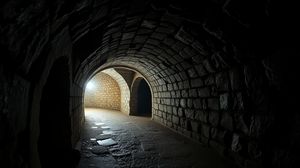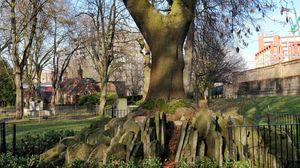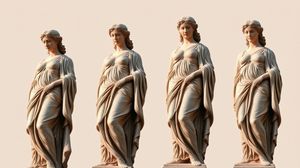
Greater London House, once known as the Carreras Cigarette Factory, is a remarkable example of Art Deco architecture in London. Constructed in the late 1920s, this building stands as a testament to the extravagant design trends of the time, showcasing intricate Egyptian-themed embellishments that make it a unique landmark.
The building originally housed the Carreras Tobacco Company, which was known for its Black Cat cigarette brand. It was one of the first factories in Britain to use modern production techniques including air conditioning and dust extraction, remarkable technological advancements for that era.
One of the architectural highlights of Greater London House is the pair of seven-foot high bronze cats that stand as sentinels on either side of the entrance. These cats pay homage to the Egyptian motif and were originally believed to represent the Egyptian cat goddess Bastet.
In contrast to its industrial origins, the building today houses office spaces and is one of Camden's iconic commercial landmarks. The transformation of the Carreras building from a tobacco factory to a modern office space reflects the adaptive reuse trend in architecture.
The building's unique design also extends to its decorative facade. It was once adorned with vibrant colours and intricate details, much like an ancient Egyptian temple. Today, even though the colours have changed, its distinct architectural features continue to capture the imagination of passersby.
Though the large production floors and machinery rooms are no longer in use, the spirit of innovation and distinctive style of the Carreras Cigarette Factory lives on through its eye-catching facade and the stories embedded in its walls.
Greater London House has undergone several refurbishments since its days as a cigarette factory, yet it remains an outstanding piece of London's architectural history, effortlessly blending the grandeur of its past with the realities of its present-day function.

Making the Most of Your Visit:
First off, when you're at Greater London House, take a moment to really study those grand bronze cats flanking the entrance. They're not just eye-catching; they're central to the building's historical charm and Egyptian theme. And here's a fun tidbit: there used to be a whole line of smaller cats leading up to the entrance back in the day, though they've disappeared over time.
If you're into architecture or just love a good story, try and catch the building in the morning or late afternoon. The way the light hits the facade really brings out the intricate details of the Art Deco and Egyptian motifs. It's these small things that highlight the building's grandeur and history.
While you're in the area, it's well worth taking a short walk along Hampstead Road to see the dramatic Egyptian revival style juxtaposed with modern-day London architecture. It gives you a real sense of the evolution of the city's landscape over the decades.
If you're visiting during the weekdays, you might notice the hustle and bustle as people head to their offices. To get a fuller sense of its grand past, try visiting on a weekend when it's quieter and you can appreciate the building's exterior more leisurely.
Although you can't go inside and explore like a museum, Greater London House makes a great starting point to explore the eclectic character of Camden, with the vibrant Camden Market just a short walk away. It offers an interesting contrast between historic architecture and contemporary urban life.

Visiting Times & Costs:
While Greater London House, formerly the Carreras Cigarette Factory, is a landmark known for its striking architectural features, it is not open to the public for tours or visits in the traditional sense. The building now serves as an office space and does not operate as a museum or public attraction.
There are no entrance fees as access to the interior is primarily restricted to employees and business purposes. However, the external architectural features can be appreciated from Hampstead Road without any cost.
Visitors are welcome to admire the building from the outside at any time. It is important to note that because it is a functioning office building, the area around it is busiest during weekday working hours, and a more relaxed visit might be experienced during the weekends or outside of typical office hours.
As this is an exterior visit, accessibility considerations largely concern the street-level approach, which includes standard pavements along Hampstead Road. The site is accessible for wheelchair users and those with mobility challenges to view from the roadside.

Address & Map:

Nearby:























